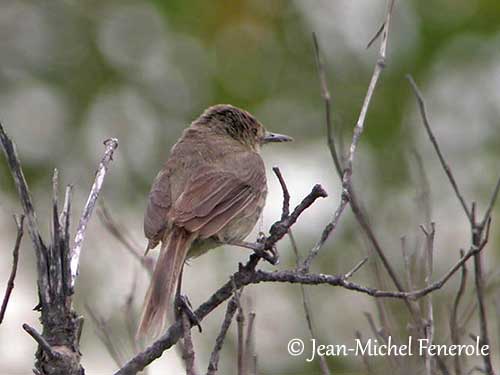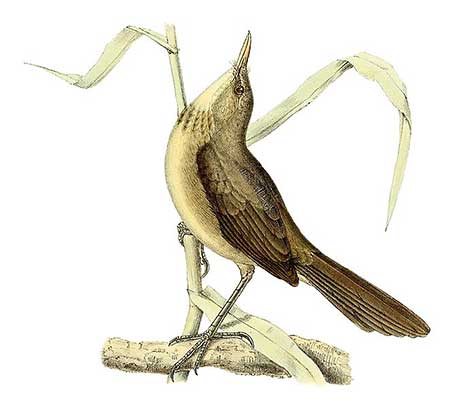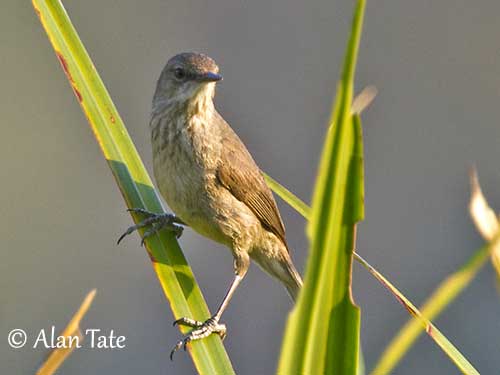
Fr: Rousserolle de Newton
Ang: Madagascan Swamp-Warbler
All: Madagaskarrohrsänger
Esp: Carricero Malgache
Ita: Cannaiola del Madagascar
Nd: Madagaskarrietzanger
Sd: madagaskarrörsångare
Mal: tretreka, Vorombararata, Vorombatra
Photographer:
Jean Michel Fenerole
Photos d’Oiseaux du monde
Alan & Ann Tate
AA Bird Photography
Illustration:
John Gerrard Keulemans (1842-1912)
Origine de l’illustration
Recherches sur la faune de Madagascar et de ses dépendances d'après les découvertes de François P.L. Pollen et D.C. van Dam
Text by Nicole Bouglouan
Sources:
HANDBOOK OF THE BIRDS OF THE WORLD Vol 11 by Josep del Hoyo, Andrew Elliott and David Christie - Lynx Edicions - ISBN: 849655306X
Reed and Bush Warblers Par Peter Kennerley, David Pearson – Helm Identification Guide – Editeur: A&C Black, 2010 – ISBN: 1408134012, 9781408134016
Birds of Madagascar and the Indian Ocean Islands Par Roger Safford, Adrian Skerrett, Frank Hawkins – ISBN: 1472924118, 9781472924117- Editeur: Bloomsbury Publishing, 2015
Wildlife of Madagascar par Ken Behrens,Keith Barnes - ISBN: 140088067X, 9781400880676 – Editeur: Princeton University Press, 2016
Patterns of morphological and molecular variation in Acrocephalus newtoni on Madagascar
Madagascan Swamp-Warbler
Acrocephalus newtoni
Passeriformes Order – Acrocephalidae Family
INTRODUCTION:
The Madagascan Swamp-Warbler is endemic to Madagascar and occurs in a variety of wetlands with reedbeds and sedges, and in mangroves. It feeds on insects caught in the dense marshy vegetation. It rarely flies or only between clumps of reeds while hunting. It often flies with the trail spread.
The species is widespread or locally common throughout its range, and it is not globally threatened.
DESCRIPTION OF THE BIRD:
Biometrics:
Length: 18 cm
Weight: 14,5-20 g
The Madagascan Swamp-Warbler is a large, slender warbler with short, rounded wings and long-graduated tail.
It has dark greyish-brown to dark brown upperparts including wings and tail.
The underparts are greyish-white, but flanks and belly are tinged buff to pale brownish-grey. Chin, throat and upper breast are usually streaked brown-grey, but this pattern is sometimes absent. The underwing is olive-brown and the undertail-coverts are suffused greyish-brown.
On the head, crown and hindneck are dark greyish-brown to dark brown. We can see an indistinct pale brown, narrow supercilium extending back only to the eye, and a thin dark eye stripe. Cheeks and ear-coverts are pale olive-brown with darker streaks. Nape and lower sides of neck are pale olive-brown.
The fairly long, two-tone bill has blackish upper mandible and pinkish-grey with dark tip lower mandible. The eyes are dark reddish-brown. The strong legs and feet are dark grey.

Male and female are similar.
The juvenile resembles adult, but the streaking is generally absent from chin, throat and upper breast. The bare parts are darker.
RANGE:
The Madagascan Swamp-Warbler is widely distributed throughout the island, but it is absent from the extreme N, and less common in the drier S. There is an isolated population in the Andringitra Massif.
HABITAT:
The Madagascan Swamp-Warbler is common in a variety of wetlands such as shrubby riverside, reedbeds and marshy habitats from sea-level to 2,000 metres of elevation and more.
The isolated population of Andringitra Massif is found above the tree line.
CALLS AND SONGS: SOUNDS BY XENO-CANTO
The Madagascan Swamp-Warbler gives short “chak” calls sometimes repeated in series.
The song is a loud series of liquid, deep, melodious low and high notes “chup-e weer weer, tuweep, tweep tweep weepweepweep, tuwherero… cherrep…lulululu”. We can also hear a harsh “k-cheer” and a longer “chercherchup”.
It usually sings from within the vegetation or perched on reed or stem.
BEHAVIOUR IN THE WILD:
The Madagascan Swamp-Warbler feeds primarily on insects. It forages among the dense vegetation and usually moves within the reedbed. The bird climbs reed stems and moves from one vertical stalk to another. It also performs short flights between adjacent clumps of reeds.
The breeding habits are unknown. They nest among dense vegetation and above water.
The Madagascan Swamp-Warbler is usually solitary and furtive. It is very difficult to find except when singing.

The species is sedentary on Madagascar.
The short, rounded wings and the fairly long tail do not allow long distance flight. It only performs short flights while foraging with the tail spread. The flight is low and laboured.
REPRODUCTION OF THIS SPECIES:
The breeding season takes place between May and January, with peak in November/December.
Only two nests have been described. They are cup-shaped and made with dry grasses woven together with pieces of bark and plant down. The deep cup is lined with finer similar materials and few feathers.
The nest is built among dense vegetation, 50cm/1metre above the water. It is placed inside a dense bush or suspended from reed stalks.
The female usually lays 3 eggs. No more information.
PROTECTION / THREATS / STATUS:
The Madagascan Swamp-Warbler is common and widespread in suitable habitats. It is sometimes locally common or less numerous, especially in the drier south.
The population is suspected to be stable.
The Madagascan Swamp-Warbler is not globally threatened and currently evaluated as Least Concern.
